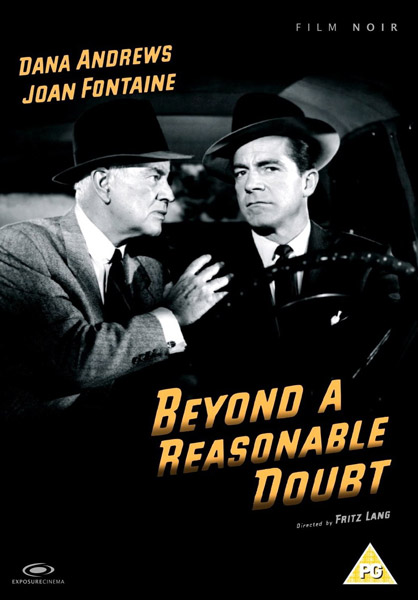 This was Lang's last film in America (1956) before he returned to Germany. It was a B movie, and I approached it as a completist, not expecting much. It does have some of the look of a great career winding down and fizzling out: we notice obvious budget limitations, fading stars (Andrews and Fontaine are too old for their roles), and a kind of flatness in the look and performances, as if everyone is going through the motions. To which list of criticisms one might add a plot even more preposterous than the preceding While the City Sleeps. No need to rehearse it here - before any details, though, the basic premise is odd. Two men decide to show the justice system is flawed by deliberately framing one of them for murder. But what actually would this prove? It would just show that if you were determined to waste police time and pervert the course of justice you could probably incriminate yourself (and it would help if the police were heroically incurious, too). But what would it tell us about 'reasonable doubt'? Not much. It might show that a verdict can be reasonable but wrong. But everyone knows that already.
This was Lang's last film in America (1956) before he returned to Germany. It was a B movie, and I approached it as a completist, not expecting much. It does have some of the look of a great career winding down and fizzling out: we notice obvious budget limitations, fading stars (Andrews and Fontaine are too old for their roles), and a kind of flatness in the look and performances, as if everyone is going through the motions. To which list of criticisms one might add a plot even more preposterous than the preceding While the City Sleeps. No need to rehearse it here - before any details, though, the basic premise is odd. Two men decide to show the justice system is flawed by deliberately framing one of them for murder. But what actually would this prove? It would just show that if you were determined to waste police time and pervert the course of justice you could probably incriminate yourself (and it would help if the police were heroically incurious, too). But what would it tell us about 'reasonable doubt'? Not much. It might show that a verdict can be reasonable but wrong. But everyone knows that already. Add to that Dana Andrews's slide into inexpressiveness, the apparent indifference to things like suspense and plausibility (like the Downton Christmas Special, a reported remark to which there are no other witnesses can be damning, apparently), and it should be a write-off. But the odd thing is, it isn't. Lang is clearly pursuing soicial inquiry again here, and the focus gets rid of distracting subplots and psychoanalytical waffle, giving a clear storyline. And a close look at capital punishment might perhaps have been more unusual half a century ago. Weaknesses become strengths. The dialogue, delivered almost entirely without raised voices, is rather theatrical and weirdly compelling, as if it is not even trying to be real. The antagonists don't seem to mind each other, really, but that only adds to a picture of society as a closed system, where media magnates, prosecutors and defenders are all really in the same club. Other touches - the onlookers roaring with laughter at a murder trial, the split-second timing of turning on the television just as the programme starts, the film of the trial (in 1956?), the 'Pardon' lying on the Governor's table like a gift certificate - all these give the piece an offbeat quality. Is the film pointing to its own artificiality, or testing our suspension of disbelief as viewers? And there, beneath the semi-surreal plot is the point of it, the heart of Lang's vision: everything in thisd world collapses into pretence, cynicism, doubt, lies, guilt, suspicion, hypocrisy. Images of mirrors and doubles echo the double life we see on the screen, and the girls in the burlesque clubs are essentially doing the same thing as the main characters, putting on an act . In the end, poetic justice is delivered, choices are made and destinies freely chosen. Beyond a Reasonable Doubt is a social melodrama, but also a final noir film, a disturbing dream which wo't go away.